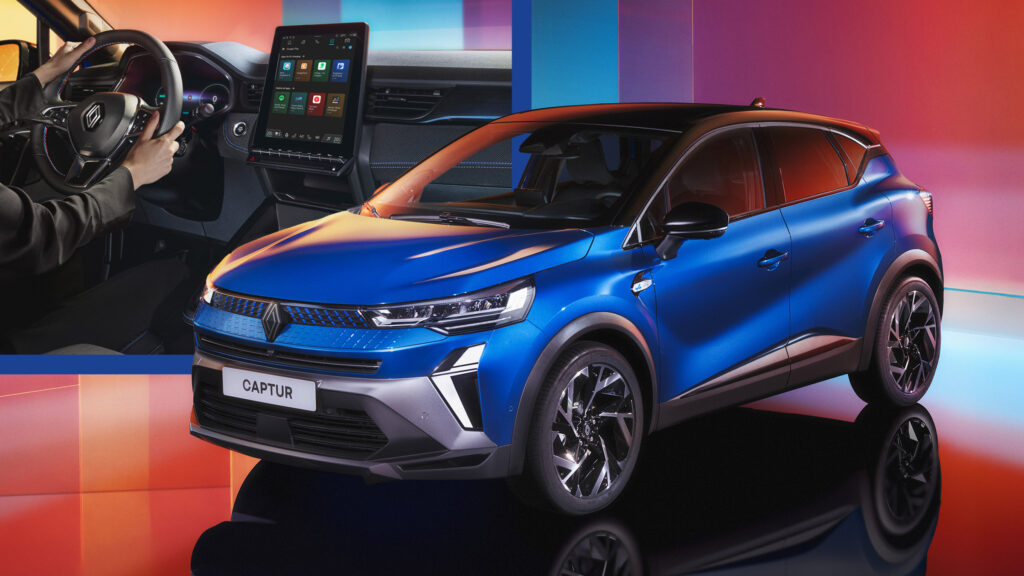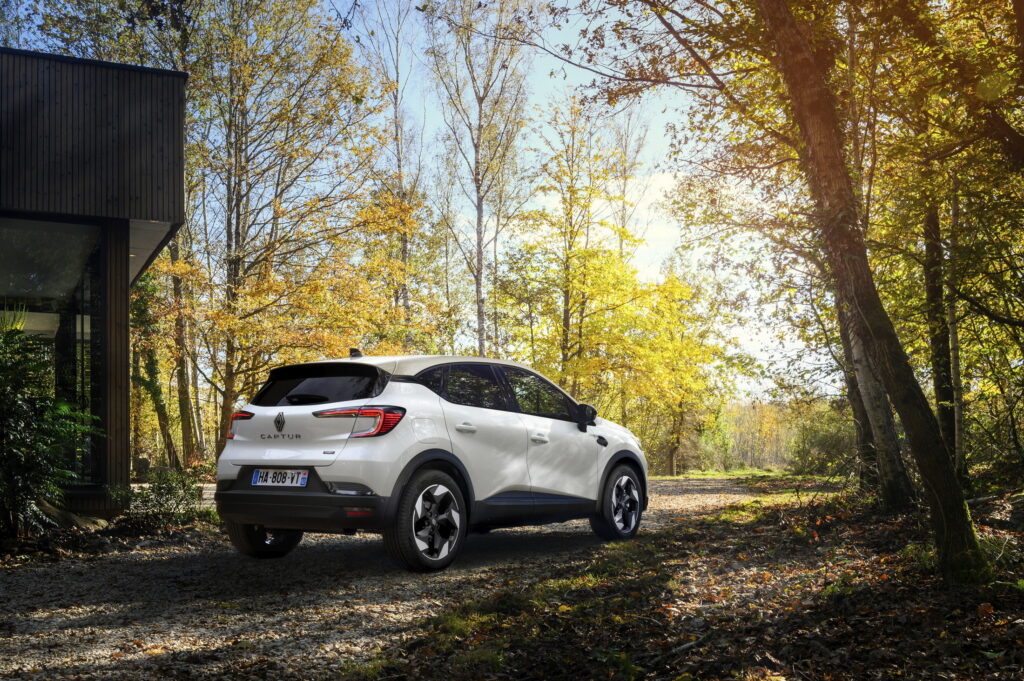- The redesigned face makes the Captur look more premium
- New screens and sustainable upholstery inside the cabin
- The Esprit Alpine is the new flagship trim, replacing the RS Line
- Available with gasoline, LPG, mild-hybrid, and full hybrid powertrains
The Renault Captur, the subcompact SUV sibling of the Clio, received a mid-lifecycle update, adopting the automaker’s latest styling language and more technology inside the cabin. The facelifted model is free of leather and chrome, in line with Renault’s sustainability commitment, while the flagship Esprit Alpine trim has been added to the top of the range. The powertrain lineup is largely carried over including gasoline, LPG, mild hybrid, and full hybrid versions, but no diesels.
The 2024 Renault Captur features a redesigned face, looking similar to the Scenic E-Tech, and the larger Rafale. The goal of the designers – headed by Gilles Vidal – was a more premium stance for the urban SUV. In this context, the new headlights come standard with full-LED technology and are joined by arrow-shaped DRLs on the tweaked front bumper. The rest of the bodywork is pretty much unchanged, although the taillights feature revised LED graphics. The Captur finally gets the updated Renault emblem, and is offered with 14 color combinations and new wheel designs ranging from 17 to 19 inches.
More: New Renault 5 E-Tech Is A Retro Mini Cooper EV Rival For $27,000
The new Esprit Alpine trim replaces the discontinued RS Line as the new flagship of the range. It is visually distinguished from the Slate Gray bumper inserts, the gloss black accents and the version-specific 19-inch alloy wheels. Inside, it features a sustainable “multi-textured” fabric upholstery instead of leather, Alpine and French flag emblems, blue stitching, a blue-gray insert on the dashboard, and aluminum pedals.
The digital cockpit of the facelifted Captur has been upgraded with a new 10.25-inch digital instrument cluster, and a slightly larger 10.4-inch touchscreen for the OpenR infotainment. The latter features Google built-in running on the latest Android Automotive 12 software. Occupants have access to USB-C charging ports (two or four), a wireless charging pad, ambient lighting that adapts to the hour of the day, and an optional nine-speaker Harman Kardon audio system.
Renault Captur Esprit Alpine
The 4,239 mm (166.9 inches) long SUV retains its family-friendly character. The spacious interior has sliding rear seats, 24.7 lt (0.9 cubic feet) of in-cabin storage, and a boot size ranging between 484-616 lt (17.1-21.8 cubic feet) in five-seater configuration.
Chassis Tweaks And Carry-Over Powertrains
The facelifted Captur retains the tried-and-tested CMF-B underpinnings. However, Renault engineers tweaked the suspension geometry, the characteristics of the shock absorbers, and the steering calibration, with the goal of improving driving pleasure. Furthermore, the most powerful versions are equipped with all-new shocks, and the Esprit Alpine rides on stickier 225/45R19 Michelin tires.
More: 2024 Citroen C3 Aircross Coming As A Junior 7-Seater Crossover
The powertrain lineup is carried over from the pre-facelifted Captur. The entry-level turbo 1.0-liter TCe three-cylinder engine makes 89 hp (66 kW / 90 PS), or 99 hp (74 kW / 100 PS) in LPG form and is mated to a six-speed manual. The more potent turbo 1.3-liter TCe four-cylinder with a 48V mild-hybrid system is good for 138 hp (103 kW / 140 PS) when paired with the six-speed manual or 158 hp (118 kW / 160 PS) when combined with the EDC automatic. Some markets also get a non-electrified 1.3-liter TCe with 153 hp (114 kW / 155 PS).
Renault Captur Techno
Finally, the most efficient option is the E-Tech hybrid producing a combined 143 hp (107 kW / 145 PS). The setup comprises a naturally-aspirated 1.6-liter engine, two electric motors, a 1.2 kWh battery, and a multi-mode “dog-clutch” automatic transmission sending power to the front axle. According to Renault, over 41% of Captur customers in France opt for the full hybrid. Weirdly, there is no mention of the plug-in hybrid derivative which was previously available, but we guess it could be added to the lineup sometime in the future.
Unlike the rugged Dacia Duster sibling which is available in AWD configuration, all versions of the facelifted Renault Captur are FWD. However, alongside the Multi-Sense driving modes (Eco, Sport, Comfort, and MySense), Renault added an optional Extended Grip setting (Snow / All-Terrain) which can improve traction on light off-roading situations. Safety equipment has also been improved, with up to 28 ADAS systems including the context-aware Active Driver Assist, and the optional Hybrid Predictive Driving.
Rivals and Availability
The 2024 Renault Captur will be available in European markets from April 2024. As with its predecessor, the SUV will be produced at Renault’s Valladolid plant in Spain. Pricing will be announced in the coming weeks.
Rivals of the French model in Europe’s crowded B-SUV (subcompact) segment include the Peugeot 2008, Ford Puma, Nissan Juke, VW T-Cross, and Skoda Kamiq, which have also been recently facelifted. In order to fight the upcoming Citroen C3 Aircross and Opel Frontera siblings which are expected to adopt a three-row layout, the Renault Captur will soon be joined by the mechanically related Symbioz, featuring a longer body and an even more spacious interior. Finally, on the fully electric front, Renault is working on the similarly-sized R4 crossover that is also expected to debut later in 2024.






































































































